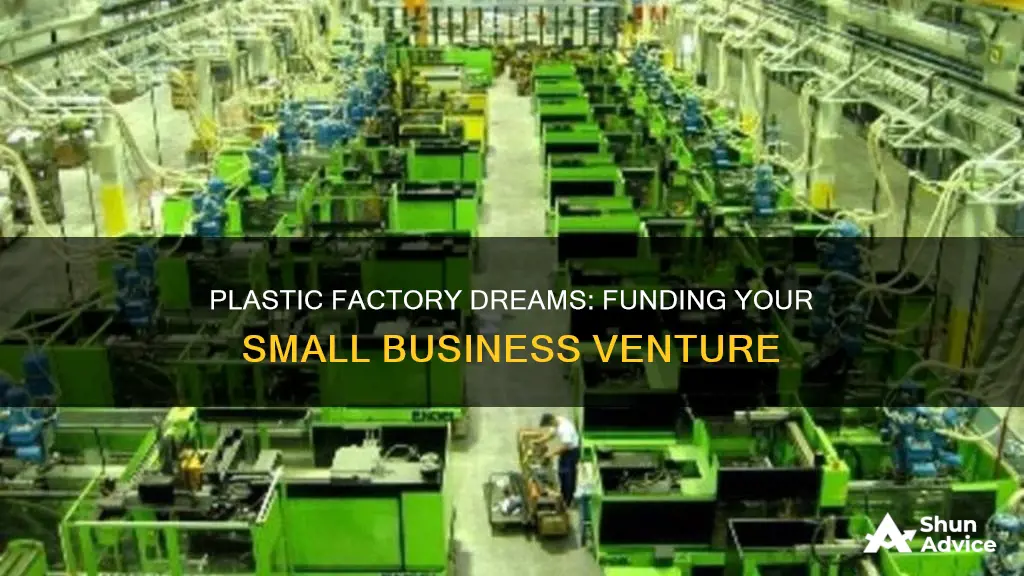
Plastic is an integral part of modern life, from toothbrushes to vehicles, and it offers a vast range of applications. Starting a small plastic factory requires a robust business plan, a clear vision, and a substantial investment in funds, time, and knowledge. Here are the key steps to help you get started:
- Market Research: Understand the market demand, supply chain, potential losses, growth opportunities, and environmental impact.
- Location: Choose a strategic location that is away from residential areas due to plastic's hazardous nature. Consider proximity to suppliers, markets, and transportation accessibility.
- Permits and Licenses: Obtain necessary permits and licenses, including factory licenses, GST registration, and consent from the State Pollution Control Board.
- Business Size: Decide on the scale of your business based on your financial strength, resources, and goals. Starting small and expanding over time is often a prudent strategy.
- Investment: Determine the investment required for machinery, raw materials, labour, marketing, and licensing. Consider funding options such as personal funds, investors, or loans.
- Machinery: Procure high-quality machinery such as injection moulding, extrusion, and blow moulding machines, along with auxiliary equipment.
- Raw Materials: Source primary raw materials like polymers (HDP, LDP, PP, PVC) and additives from local suppliers or online platforms.
- Marketing: Establish a strong brand identity, create a professional website, and utilise social media to reach a wider audience.
| Characteristics | Values |
|---|---|
| Business Plan | A clear vision, robust plan, and thorough research are needed. |
| Investment | Small-scale operations may require 10-30 lakhs, while medium to large-scale units may need several crores. |
| Location | The factory should be away from the city or on its outskirts. |
| Space | Small-scale operations require 1,000-2,000 sq ft, while large-scale operations need 5,000-10,000 sq ft. |
| Machinery | Injection molding, extrusion, and blow molding machines are common. |
| Raw Materials | Primary raw materials include polymers like HDP, LDP, PP, and PVC, and additives such as colorants and stabilizers. |
| Licenses | A factory license, GST registration, and permits from the State Pollution Control Board are essential. |
| Marketing | Establish a brand identity, create a website, and leverage social media. |
What You'll Learn

Funding sources for small plastic factories
Traditional Funding Sources:
- Bank Loans: When starting a plastic manufacturing business, one can approach banks or financial institutions for loans. This option provides access to capital required for machinery, raw materials, and other operational expenses. It is important to have a solid business plan and financial projections to secure funding.
- Investors: Seeking investors who believe in your vision and are willing to provide financial backing can be an option. This may involve giving up a portion of ownership and control, so finding investors who align with your values and long-term goals is crucial.
- Government Grants and Subsidies: Governments often provide grants, subsidies, or low-interest loans to support local industries, including plastic manufacturing. These opportunities can help reduce the financial burden on small businesses and promote economic growth.
Online Funding Sources:
- Crowdfunding: With the rise of online platforms, crowdfunding has become an increasingly popular way to raise funds for small businesses. It involves pitching your business idea to a large number of potential investors, who can contribute smaller amounts to help you reach your funding goal.
- Online Lenders: There are now many online lending platforms that offer business loans with competitive interest rates. These lenders often have faster application processes and more flexible requirements than traditional banks, making them a convenient option for small businesses.
- Angel Investors: Angel investors are typically high-net-worth individuals who invest their personal funds in promising startups or small businesses. They may provide funding in exchange for equity or as a loan, and they often bring valuable industry connections and mentorship along with their investment.
Strategic Partnerships:
- Suppliers and Distributors: Collaborating with suppliers and distributors can be a strategic way to secure funding. For example, you could negotiate favourable payment terms with your raw material suppliers or work out a revenue-sharing agreement with distributors, reducing the immediate need for external funding.
- Joint Ventures: Joining forces with complementary businesses or entrepreneurs in the plastic industry can help pool resources and expertise. This approach may provide access to funding and open up new markets or distribution channels.
Bootstrapping:
- Personal Savings: Using your personal savings or investments to fund your small plastic factory is an option if you have the financial means. This approach allows you to retain full ownership and control of your business but requires careful financial planning to ensure you have sufficient capital for both the initial setup and ongoing operations.
- Retained Earnings: As your plastic factory generates revenue, reinvesting those profits back into the business can be a sustainable way to fund growth. This approach may take longer but helps you avoid debt or giving up ownership stakes.
Regardless of the funding source you choose, it is essential to have a well-thought-out business plan, thorough market research, and a clear understanding of the financial requirements and potential risks involved in starting a small plastic factory.
Mutual Funds: Not a Get-Rich-Quick Scheme
You may want to see also

Business plan essentials
Market Research
Before starting a plastic manufacturing business, it is crucial to conduct thorough market research to understand the demand for plastic products, the supply chain dynamics, market functioning, potential losses, growth opportunities, quality control, and environmental impact. This knowledge will enable better decision-making and help avoid business pitfalls.
Location and Space
The location of your plastic manufacturing plant should be carefully chosen, keeping in mind that it needs to be away from residential areas due to the hazardous nature of plastic. Consider the proximity to raw material suppliers, markets, transportation accessibility, and the availability of adequate space for manufacturing, power supply, utilities, and office setup. For small-scale operations, 1,000 to 2,000 square feet of space is typically sufficient.
Permits and Licenses
Obtaining the necessary permits and licenses is a mandatory step to ensure legal compliance and avoid future troubles. This includes registering your business, obtaining GST registration, factory licenses, and permits from the relevant authorities, such as the State Pollution Control Board. Depending on the scale of your operation, you may also need additional licenses like MSME registration, trade licenses, and NOC from the fire department.
Investment and Machinery
The investment required for plastic product manufacturing depends on the scale and scope of your business. Small-scale operations may demand around 10 to 30 lakhs, while larger-scale units could require several crores. It is essential to conduct market research and feasibility studies to determine the precise investment needed for machinery, raw materials, labour, marketing, and licensing. Invest in high-quality machinery such as injection moulding, extrusion, and blow moulding machines, along with auxiliary equipment like grinders, mixers, and conveyors.
Raw Materials and Supply Chain
The primary raw materials for plastic product manufacturing include polymers like HDP, LDP, PP, and PVC, as well as additives such as colorants, stabilizers, and fillers. Establish relationships with reliable suppliers or source them from online platforms like IndiaMart, Alibaba, or Trade India. Additionally, focus on developing a robust supply chain to ensure the consistent availability of raw materials at competitive prices.
A Beginner's Guide to Investing in Nasdaq Funds
You may want to see also

Location and space considerations
When starting a small plastic factory, there are several location and space considerations to keep in mind.
Firstly, it is crucial to choose a site that is away from residential areas, preferably on the outskirts of a city. This is because plastic manufacturing can be hazardous to the environment, and it is important to minimise the impact on human health. Additionally, the distance between the manufacturing plant and the storage warehouse should be minimised to reduce transportation costs, a significant expense for any business.
Other important factors to consider when choosing a location include the distance to suppliers and the availability of amenities such as water and electricity supply. It is also essential to ensure that the factory has adequate space for manufacturing, power supply, utilities, and an office. For small-scale operations, a space of 1,000 to 2,000 square feet is typically sufficient, while large-scale operations may require 5,000 to 10,000 square feet or more.
When it comes to the factory space itself, it is important to have a clean and closed space with proper ventilation to avoid suffocation. The factory should also have dedicated areas for dumping plastic waste and storing recycled products. In terms of utilities, a reliable electricity connection and water supply are crucial, as well as a generator for emergency backup.
Furthermore, when considering location and space, it is essential to comply with legal requirements and obtain the necessary permits and licenses. This includes registering the business and obtaining documentation such as GST registration, permits, and licenses. Consulting with knowledgeable professionals and visiting government offices can help ensure that all the necessary requirements are met.
Overall, choosing the right location and having adequate space are critical factors in the success of a small plastic factory. By carefully considering these aspects, you can create a safe and efficient manufacturing environment while also minimising costs and maximising profitability.
Strategies for Funding a 20% Down Payment on Investment Property
You may want to see also

Machinery and equipment requirements
Machinery is one of the most crucial aspects of starting a small plastic factory. Here are the essential details on machinery and equipment requirements:
Injection Molding Machines:
The most common type of machinery used in plastic manufacturing is injection molding machines. These machines melt plastic and inject it into molds to create various plastic products. You will need to invest in high-quality injection molding machines that are suitable for the specific products you plan to manufacture.
Extrusion and Blow Molding Machines:
In addition to injection molding, extrusion and blow molding processes are also used in plastic manufacturing. You may need to invest in extrusion equipment if your factory will be producing plastic tubes, pipes, or similar products. Blow molding machines are used to create hollow plastic products, such as bottles or containers.
Auxiliary Equipment:
Don't forget the auxiliary equipment that supports the primary molding machines. This includes grinders or mixers for processing plastic granules, conveyors for transporting materials, and other equipment to ensure efficient production.
Maintenance and Upgrades:
Regular maintenance of your machinery is vital to ensure smooth operations and high-quality products. Stay on top of maintenance schedules and be prepared for occasional breakdowns. Additionally, keep your machinery upgraded to the latest standards to improve efficiency and product quality.
Installation and Setup:
When procuring machinery, consider the installation and setup process. Factor in the space required for each machine, as well as any necessary utilities like power supply and cooling systems. Ensure that your factory layout is designed to optimize the workflow between different machines and equipment.
Choosing the Right Machinery:
When selecting machinery, consider the specific products you want to manufacture. Different types of plastic products may require different types of molding machines and auxiliary equipment. It is essential to match the machinery to your production needs.
Procurement and Costs:
Machinery procurement can be a significant cost center for your business. It is essential to consider the upfront investment required and factor in recurring maintenance costs. Compare prices and features from different suppliers to make an informed decision.
Skilled Operators:
Ensure that you have skilled professionals who can operate and maintain the machinery. Provide training if necessary to bring your staff up to speed with the latest equipment and technologies.
Safety Measures:
Plastic manufacturing machinery can be hazardous. Implement strict safety measures and provide personal protective equipment (PPE) for your workers. Ensure that your machinery is compliant with safety regulations to minimize risks.
Environmental Considerations:
Given the environmental impact of plastic manufacturing, consider investing in equipment that helps reduce emissions and improve waste management. Look for energy-efficient machinery and explore options for recycling or repurposing plastic waste.
Future Expansion:
Finally, keep in mind that your machinery requirements may change as your business grows. Be prepared to upgrade or expand your machinery to meet increased production demands or introduce new product lines.
In summary, starting a small plastic factory requires a significant investment in machinery and equipment. By carefully considering the above factors, you can make informed decisions about your machinery requirements and set up your factory for success.
Index Funds: Where to Start and What to Know
You may want to see also

Marketing and branding strategies
Marketing and branding are essential components of a successful business in the plastic industry. Here are some strategies to consider for your small plastic factory investment funding:
- Online Presence: Establish a strong online presence through a user-friendly website and active social media accounts. This enables you to showcase your products, provide detailed information, and reach a wider audience, including potential business customers and end consumers.
- Sponsorships: Consider sponsoring events or teams as a way to raise the public profile of your business. Long-term sponsorships that occur over a period of time, rather than one-off events, can be more effective in building brand awareness. Target sponsorships that align with your specific marketing goals and consider partnering with complementary businesses to maximize impact and minimize costs.
- Direct Mail Campaigns: Invest in professional mailing lists to improve the return on investment (ROI) of your direct mail campaigns. Vendors can help you target likely buyers, ensuring your messages reach the right audience and reducing unnecessary costs.
- Diversify Advertising Channels: Explore a variety of advertising vehicles to communicate your brand message effectively. Online advertising, for example, offers the advantage of cost-effective messaging to a highly segmented customer base. Stay up to date with industry trends and be open to innovative strategies to ensure you don't fall behind your competitors.
- Networking and Partnerships: Building relationships with potential customers, suppliers, and industry partners is crucial. Attend industry events, join relevant associations, and seek opportunities to collaborate. A strong network can provide valuable insights, support, and potential business leads.
- Environmental Awareness: Given the environmental impact of the plastic industry, incorporating eco-friendly practices into your business model and marketing strategy can help enhance your brand image. Consider using recycled materials, implementing sustainable production methods, and promoting your commitment to environmental responsibility.
- Competitive Pricing: Price your products competitively to attract customers and establish your position in the market, especially when starting. Penetration pricing, where you offer lower prices than your competitors, can help you gain a foothold in the industry and build customer loyalty.
Monthly Mutual Fund Investments: A Smart, Secure Financial Strategy
You may want to see also
Frequently asked questions
First, you'll need a robust business plan and a clear vision. You should also be aware of all the environmental safety measures and regulations you'll need to follow. It's important to conduct thorough market research and gain a deep understanding of the industry, including the machinery, raw materials, and potential environmental impacts.
The investment required depends on the scale and scope of your business. Small-scale operations may demand around 10 to 30 lakhs, while medium to large-scale units could require several crores. The main expenses will be machinery, labour, raw materials, marketing, and licensing.
You will need a factory license, GST registration, and permits from the State Pollution Control Board. Depending on your location and scale, you may also need MSME registration, a trade license, and NOC from the fire department.
Common machines include injection moulding, extrusion, and blow moulding machines. You will also need auxiliary equipment like grinders, mixers, and conveyors.
You can use personal funds, find investors, or take out loans. If your business falls into a specific category, such as women-owned or veteran-owned, you may be eligible for funding from organisations like the Small Business Administration (SBA).







